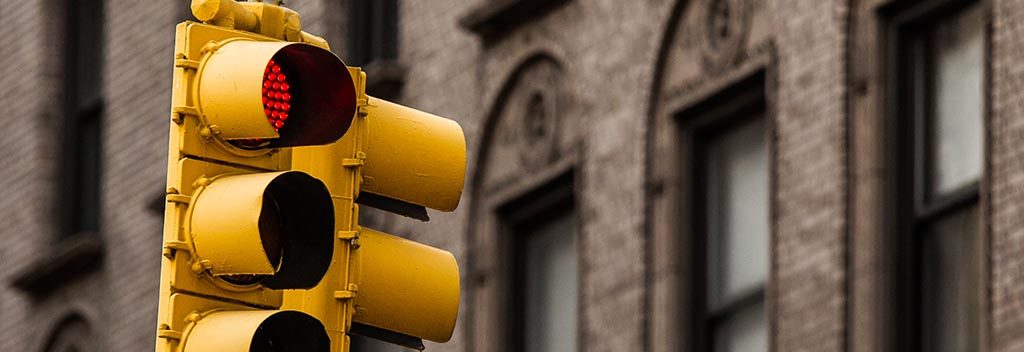
WASHINGTON, D.C. (Aug 29, 2019)- More than two people are killed every day on U.S. roads by impatient and reckless drivers blowing through red lights, according to data analysis performed by the AAA Foundation for Traffic Safety. The most recent crash data available shows 939 people were killed in red light running crashes in 2017 — a 10-year high and a 28% increase since 2012. With the number of red light running crashes on the rise, AAA calls for drivers to use caution when approaching signalized intersections, and for pedestrians and cyclists to stay alert when crossing the street.
According to the AAA Foundation:
- 28% of crash deaths that occur at signalized intersections are the result of a driver running through a red light.
- Per capita, Arizona has the highest rate of red light running fatalities while New Hampshire has the lowest rate.
- Nearly half (46%) of those killed in red light running crashes were passengers or people in other vehicles and more than 5% were pedestrians or cyclists. Just over 35% of those killed were the drivers who ran the red light.
“Drivers who decide to run a red light when they could have stopped safely are making a reckless choice that puts other road users in danger,” said Dr. David Yang, executive director of the AAA Foundation for Traffic Safety. “The data shows that red light running continues to be a traffic safety challenge. All road safety stakeholders must work together to change behavior and identify effective countermeasures.”
According to the AAA Foundation’s latest Traffic Safety Culture Index, 85% of drivers view red light running as very dangerous, yet nearly one in three say they blew through a red light within the past 30 days when they could have stopped safely. More than 2 in 5 drivers also say it is unlikely they’ll be stopped by police for running a red light. Nevertheless, it’s against the law and if a driver is involved in a deadly crash, it could send them to jail.
While enforcement is the best way to get drivers to comply with any law, it is impossible for police to be at every intersection. The Insurance Institute for Highway Safety (IIHS) found that when properly implemented, red light cameras reduced the fatal red light running crash rate of large cities by 21% and the rate of all types of fatal crashes at signalized intersections by 14%.
“Deaths caused by red light running are on the rise,” said Jessica Cicchino, IIHS Vice President for Research. “Cameras increase the odds that violators will get caught, and well-publicized camera programs discourage would-be violators from taking those odds. Camera enforcement is a proven way to reduce red light running and save lives.”
Proper implementation of red light cameras helps to ensure drivers’ safety and trust in the systems. When using red light camera programs, local governments should incorporate best practices, such as:
- Using the camera program as part of a comprehensive traffic safety strategy, including engineering and education.
- Only implementing programs on roadways with a demonstrated pattern of violations or crashes.
- Notifying drivers that cameras are being used (signage and other methods).
- Calibrating cameras regularly.
- Only operating cameras under the direct supervision of law enforcement personnel.
- Evaluating the programs on a periodic basis to ensure safety benefits are being realized.
Changes in driver behavior are also critical to reducing the number of red light running crashes on U.S. roads. To prevent red light crashes, AAA recommends that drivers:
- Prepare to Stop: Lift your foot off the accelerator and “cover the brake” when preparing to enter any intersection by positioning your right foot just above the brake pedal, without touching it.
- Use Good Judgment: Monitor “stale” green lights, those that have been green a long time as you’ve approached the intersection. They are more likely to turn yellow as you arrive at the intersection.
- Tap the Brake: Tap your brakes a couple of times before fully applying them to slow down. This will catch the attention of drivers who may be inattentive or distracted behind you.
- Drive Defensively: Before you enter an intersection after the light has turned green for you, take a second after the light changes and look both ways before proceeding.
Pedestrians and cyclists should also stay safe when traveling near intersections. AAA recommends:
- Wait: Give yourself a few seconds to make sure all cars have come to a complete stop before moving through the intersection.
- Stay Alert and Listen: Don’t take chances and don’t wear headphones. Watch what is going on and give your full attention to the environment around you.
- Be Visible: Stay in well-lit areas, especially when crossing the street.
- Make Eye Contact: Look at drivers in stopped vehicles to ensure they see you before crossing the road in front of them.
About AAA Foundation for Traffic Safety: Established in 1947 by AAA, the AAA Foundation for Traffic Safety is a nonprofit, publicly funded, 501(c)(3) charitable research and educational organization. The AAA Foundation’s mission is to prevent traffic deaths and injuries by conducting research into their causes and by educating the public about strategies to prevent crashes and reduce injuries when they do occur. This research is used to develop educational materials for drivers, pedestrians, bicyclists and other road users. Visit www.AAAFoundation.org.
About AAA: AAA provides more than 59 million members with automotive, travel, insurance and financial services through its federation of 34 motor clubs and nearly 1,100 branch offices across North America. Since 1902, the not-for-profit, fully tax-paying AAA has been a leader and advocate for safe mobility. Drivers can request roadside assistance, identify nearby gas prices, locate discounts, book a hotel or map a route via the AAA Mobile app. To join, visit AAA.com.
